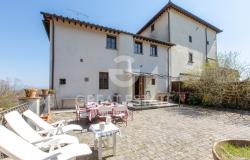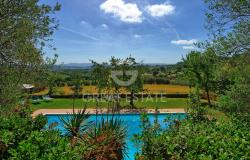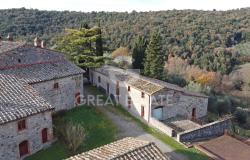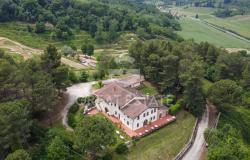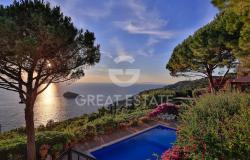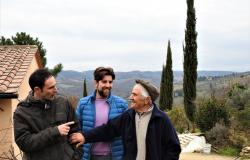Having a scholar in your family can be very boring but sometimes very useful. My daughter is reading Medieval Archaeology at the Scuola Normale Superiore in Pisa and her obsession about everything related to Medioevo is quite understandable. She is always in search of anything with a medieval flavour and her research brought us, last August, to Volterra.
Situated in the heart of Tuscany, right in the middle - and almost on top of it, at 1770 feet above sea level – Volterra is of one of the most beautiful landscapes in Italy: the Colline Toscane. Well known mainly for its Etruscan past as Velathri and its crucial role in the Roman Age as Volaterrae - with a wealth of remains to testify to it - this little town has one of the best preserved medieval citadels.
During the beginning of the first millennium, Volterra played a strategic role among the more powerful cities of Florence, Pisa and Siena and, before being conquered by the Florentines, the town enjoyed a long period of freedom. To remember and celebrate that Golden Age, fourteen years ago a group of volterrani, decided to bring that past back, giving birth to: Volterra, Anno Domini 1398.
It is quite difficult to get to Volterra by train since the railway station is 10 km far from the town centre and at the bottom of the rocky hill, even though well connected by bus, so it is better to travel there by car. The medieval event usually takes place on the third and fourth weekends of August. Last year the first Sunday incidentally happened to overlap the 15th of August – Ferragosto – one of the busiest and crowded days in every part of the country. Nobody can convince my family to get out on that day. Let alone visit a new place with an event that can potentially attracts loads of people! Ma siamo matti? We wisely decided to go the following weekend.
Because my grumpy husband thinks staying out all day long in August is a crazy idea – he is quite right though, it is definitely too hot! - we arrived at Volterra around three in the afternoon. I was worried about finding a parking space in the middle of the day, but we had no problem. The municipality is very well organized with six parking lots just outside the Medieval Defensive Walls. By foot we entered the town through one of the many Medieval Gates: Porta San Francesco.
 Just few meters inside my daughter pointed out an epigraph – her new studying interest - about one very famous volterrano: Saint Linus, second pope after S. Peter. Then, without a clue of where to go, we followed the fluid mob and quickly arrived at the box office: just two tables in the middle of the street, one selling the tickets (nine euros per person, reduced for under 18 and over 60 years-old at five euros, and kids under 10 years-old admission free) and the other giving out the “medieval passport” (a wristband that allows visitors to enter the restricted area of the town where the event takes place and to visit the Museum of Sacred Art, the Palazzo dei Priori and the Etruscan Acropolis). They gave us also a map with all the shows and the important things to see, along with a very useful timetable.
Just few meters inside my daughter pointed out an epigraph – her new studying interest - about one very famous volterrano: Saint Linus, second pope after S. Peter. Then, without a clue of where to go, we followed the fluid mob and quickly arrived at the box office: just two tables in the middle of the street, one selling the tickets (nine euros per person, reduced for under 18 and over 60 years-old at five euros, and kids under 10 years-old admission free) and the other giving out the “medieval passport” (a wristband that allows visitors to enter the restricted area of the town where the event takes place and to visit the Museum of Sacred Art, the Palazzo dei Priori and the Etruscan Acropolis). They gave us also a map with all the shows and the important things to see, along with a very useful timetable.
And there we were: one step before in the aseptic Third Millennium, one step after into the chaotic and chatting Medioevo!
My children went immediately to the Offizio di Cambio to exchange their Euros into the only currency accepted for the day: the grosso volterrano. 1 Grosso, copper coin, 1 Euro; 5 Grossi, gold coin, 5 Euros. With that money you can buy whatever you like, form food to souvenirs, but most of the shops are more than happy to accept real money if you don't want to exchange a lot of your Euros. And, if at the end of the day you find yourself with more Grossi in your pocket than you would like to keep as a memento, you can just go to the Tourist Information Office and they will exchange them back.
As I entered the main square I was immediately attracted to the huddle of laughing people at the right corner of Palazzo dei Priori. They were all looking at a very unusual show: the pillory. Two men were playing superbly the role of executioners, bringing volunteers from the audience and putting them into a narrow hang-cage or locking their heads and hands into the stocks. And while one of the hangmen was menacing the captives with an axe, the other was dripping cold water on the back of their necks. The unfortunate volunteers couldn't help but laugh and scream at the same time.
 Looking at this amusing show was a family with three children – the little one in a pram – and all of them dressed like medieval noble people. The grandparents, however, were wearing humble peasants' clothes. They told me to go inside the Palazzo dei Priori where I could rent for one day any kind of dress or suit I liked, from a noble-dame to a beggar, from a knight to a friar. But when I entered the palace, I was caught by the sound of an enchanting choir that was performing medieval songs in the Hall. They had just finished their repertoire when a drum roll called us out to assist at the costume parade.
Looking at this amusing show was a family with three children – the little one in a pram – and all of them dressed like medieval noble people. The grandparents, however, were wearing humble peasants' clothes. They told me to go inside the Palazzo dei Priori where I could rent for one day any kind of dress or suit I liked, from a noble-dame to a beggar, from a knight to a friar. But when I entered the palace, I was caught by the sound of an enchanting choir that was performing medieval songs in the Hall. They had just finished their repertoire when a drum roll called us out to assist at the costume parade.
We followed the last tambourine through the packed streets to the Cathedral, where the people of the contrade – the medieval districts of Volterra – were performing a quite detailed reconstruction of many medieval occupations and crafts. There was la Bottega del Sale, where women and children demonstrated the old technique of producing salt. In front of them men were working the alabastro – an ancient craft for which Volterra is very well known around the world – while the wood artisans displayed an immense dragon sculpture. A young lady coined in front of us a new grosso and in the stalls all along the streets and the square people were offering – and selling – tasters of a wide variety of typical Tuscan foods such as cheese, bread, salami and wine. I reckon that most of the products have improved over the centuries, but otherwise not changed much at all. Lorenzo, my teenager-always-hungry son, went immediately on the hunt for free-food.
My husband and I visited the Cathedral and the Battistero, in which we lifted our spirits with an amazing lute concert, while our kids decided to invest their grossi on … betting. Among the food stalls they discovered a medieval betting game, consisting of a circle of logs with numbered holes and, in the middle, a tripod with a rope and an upside down basket trapping a guinea pig. When the basket was pulled up the scared animal would run into one of the holes. My children bet on two numbers and they were given two wooden spoons. A man lifted the basket and the poor animal... stayed put! So the betters were invited to make noises with their spoons in order to help the animal make a decision. And it worked! The guinea pig ran fast towards one of my children's chosen numbers. They brought home a delicious salami.
With our precious prize we headed back to Piazza dei Priori to see the flag-wavers show. It is unbelievable how a child can throw a flag so high or a young man can handle six flags in one shot, using his hands and his feet too. When they finished their performance we followed them to the Parco del Castello, climbing a narrow and steep street to the top.
The park was full of people and the air full of tasty smells coming from the medieval taverne rebuilt in the open air between the trees. In the centre ground a falconry show was running, while knights in helmets and armour were showing to the kids their weapons.
What immediately caught my attention was the massive castle on the far end of the park. I tried every single path in order to get closer to it, but it seemed as though there wasn't a way through. My husband cleverly noticed that a visit to the castle wasn't mentioned on our entrance ticket. It wasn't possible! I had to visit that magnificent building. So I returned to the box office at the entrance, where I discovered that my only chance to visit the Fortezza Medicea was...being arrested. The castle is a prison. I knew that Volterra was famous for hosting a huge mental centre and a high security penitentiary but never imagined one of them could have been placed in a location so striking.
The soft approaching of the summer sunset brought us back to reality. The medieval festival was lasting till midnight but we couldn't stay any longer. Just the time for a last treat: a yummy panino con la porchetta, a traditional Italian snack. I don't know if it was the flavour of the pork meat or the sweetness of the unsalted bread – typical of Tuscany - but my mouth is still watering now at the very thought.
 While heading to our car, taking the last photographs, I couldn't help picturing myself, my children and even my yet-to-come grandchildren, in those fancy medieval costumes. Next year I think my husband will be more than happy to spend the whole day in Volterra. And looking at the smiling faces of the children all over the town I made a decision: an annual trip to Volterra A.D 1398 will definitely be part of our family traditions.
While heading to our car, taking the last photographs, I couldn't help picturing myself, my children and even my yet-to-come grandchildren, in those fancy medieval costumes. Next year I think my husband will be more than happy to spend the whole day in Volterra. And looking at the smiling faces of the children all over the town I made a decision: an annual trip to Volterra A.D 1398 will definitely be part of our family traditions.
To know more about the event check the related website
http://www.volterra1398.it/

